Solving homelessness will take the full force of a collective effort focused on combating the true causes of homelessness. Since that is the case, the American public’s beliefs and attitudes about homelessness matter profoundly. They shape how people experiencing homelessness are treated, as well as homelessness policies and services. Although some research indicates that the public has become increasingly compassionate toward those experiencing homelessness and supportive of federally funded initiatives to address homelessness over the past few decades,1 many negative stereotypes and assumptions about people experiencing homelessness remain part of America’s collective consciousness, inciting prejudice and resistance to local supportive housing developments. From an individual to systemic level, people experiencing homelessness encounter a profound stigma that can serve as a substantial social barrier to addressing housing inequality.
This learning brief began by examining public perceptions of people experiencing homelessness and the inaccurate assumptions embedded within them. It seeks to equip readers with the evidence they need to affirm truths about homelessness and combat the misconceptions that perpetuate risks to people experiencing homelessness and our ability to solve this urgent social problem.

Truth: The large majority of people experiencing homelessness in a given area are either from the community in which they’re experiencing homelessness, or had been living there for multiple years before they lost housing.
People experiencing homelessness have long been stereotyped as ‘transient drifters,’2 despite evidence demonstrating that they are most often from the communities in which they currently reside. In reality, moving requires money and access to resources that most people experiencing homelessness do not have.
Data from communities across the United States do not support the assumption that people who fall into homelessness migrate to areas in search of local services and assistance. Overall, migration from low-income to high-income areas in the country has dramatically decreased in recent decades, and low-income individuals are actually moving out of high-income areas due to increased housing prices.3
- Seattle/King County, Washington: In 2018, over 83% of the people experiencing homelessness included in the Point-in-Time count had been living in King County, Washington, for over a year before they lost housing. Fifty-three percent had either lived locally for 10 years or longer, or were born and grew up in King County.4
- Los Angeles: Well over half — 68% — of those experiencing homelessness in LA County in 2019 had been living there for over 20 years, whereas 12% had spent a year or less in LA County prior to losing their housing.5
- New York City: Families entering shelters overwhelmingly come from a cluster of neighborhoods in New York City that have high poverty rates. 6
- San Francisco: Seventy percent of those experiencing homelessness in 2019 lived in San Francisco at the time they became homeless, and over half of these individuals had lived locally for 10 years or longer. 7
One of the largest studies to date analyzed migration among over 100,000 veterans experiencing homelessness for up to two years following their initial use of Veterans Affairs (VA) homeless services.8 The study found that only 15.3% of this sizable sample of veterans migrated across large geographic areas while they were experiencing homelessness. Exit rates from VA medical center (VAMC) catchment areas tended to approximate entrances, such that in-migration did not substantially impact the size of the veteran population experiencing homelessness or the demand for services in a particular location. Very few VAMCs (8 out of 128) experienced net gains or losses of veterans experiencing homelessness that exceeded 10%.
Another myth incorrectly assumes that people experiencing homelessness are drawn to urban, liberal areas where they can access generous social services.9 However, the study also found no evidence that veterans experiencing homelessness who migrated during the two-year period frequently went from rural to more urban areas.
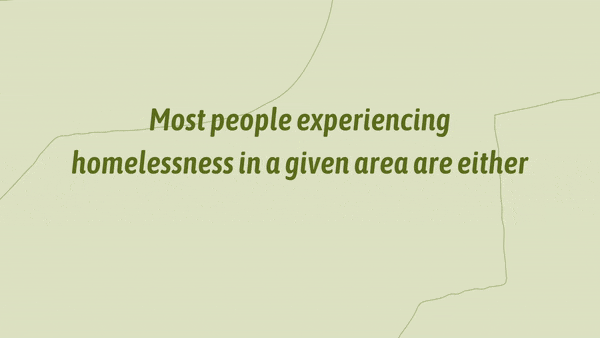
What’s at stake
It is important that we promote a widespread understanding that people experiencing homelessness are often from the community they are in, rather than migrating to areas in order to access generous social services.
The argument that offering services and assistance to individuals experiencing homelessness will make a community act as a magnet drawing people from afar to take advantage of them breeds opposition for supportive local services that is rooted in “Not-in-My-Backyard” (NIMBY) thinking. NIMBY thinking refers to a phenomenon in which Americans purport to support social services and assistance for people experiencing homelessness in the abstract, but ultimately oppose those services when they are provided in their own neighborhood. This approach has stymied necessary resources and solutions to homelessness.10 One underlying misconception that has helped perpetuate this thinking is the false belief that offering services and assistance to individuals experiencing homelessness will draw people from afar to take advantage of them. As noted above, this is not true.
Understanding that people experiencing homelessness are, in fact, our neighbors offers important context for motivating action and feelings of proximity. It combats assumptions that people experiencing homelessness in a given community are not from there, which differentiates people experiencing homelessness as outsiders, fueling indifference, and reducing empathy and willingness to help.
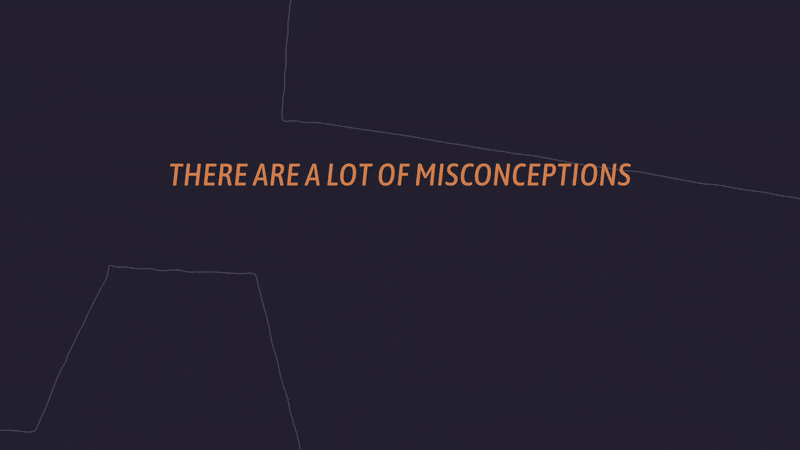
Truth: The relationship between homelessness and mental illness and substance use disorders is complex, and many people experiencing homelessness have neither type of condition. Moreover, mental illness and substance use do not predict homelessness at the community level. The best predictor of homelessness is a lack of affordable housing.
The public tends to overestimate rates of mental illness and/or substance use disorders among the population experiencing homelessness.11 Findings from two large surveys demonstrate the public also believes mental illness and/or substance abuse generate homelessness: 74% of respondents across 16 cities considered either addiction or mental illness to be causes of homelessness in their community,12 and 95% of New Yorkers considered drug and alcohol abuse as key causes of homelessness.13
This may be partly because rates of severe mental illness and substance use disorders are more prevalent among unsheltered populations,14 who are more visible to the general public. In fact, people are more likely to associate addiction and mental illness with homelessness in areas with higher rates of unsheltered homelessness.15 This misconception pertains to the tendency to overgeneralize from memorable personal interactions with or media exposure to people experiencing homelessness. Although stereotypes about these individuals are often based on experiences with individuals who are unsheltered, most people experiencing homelessness do not live on the streets or other places not designed or ordinarily used for sleeping accommodation.16
While a considerable number of individuals experiencing homelessness have a severe mental illness or substance use disorder, most estimates indicate that under half of the overall population experiencing homelessness is affected by these conditions. According to HUD, about 21% of those experiencing homelessness in 2022 reported having a severe mental illness, and 16% reported chronic substance abuse.17 In LA County, 26% of those experiencing homelessness in 2018 reported a severe mental illness, and 15% reported a substance use disorder.18
The belief that individuals are losing housing due to these conditions also overlooks that mental health conditions and substance use disorders can frequently be outcomes of experiencing homelessness. The trauma of experiencing homelessness can expose individuals to stressors that increase their vulnerability to psychological conditions, distress, and substance use disorders. As such, homelessness is recognized as a risk factor for precipitating or exacerbating mental illness symptoms and substance use.19 Rather than a one-way, cause-and-effect relationship, mental illness and homelessness are mutually reinforcing risk factors.
Studies consistently show that a lack of affordable housing is the best predictor of homelessness.20 Whereas housing markets characterized by high rent prices and low vacancy rates are shown to drive homelessness, variations in rates of homelessness across communities in the U.S. do not appear to be related to the number of individuals suffering from mental illness or substance use disorders whatsoever.21 Findings from surveys with people experiencing homelessness also provide evidence that the leading causes of losing housing are related to economic forces:
- Seattle/King County, Washington: In a 2019 survey, around 24% of those experiencing homelessness identified job loss as the primary reason they lost housing. The percentage of respondents who cited substance abuse (16%) resembled the percentage that reported eviction (15%) reasons for their homelessness.22
- Orange County, California: A 2016 survey found that people experiencing homelessness attributed losing housing to three top factors: securing or retaining jobs with sustainable wages (40%), finding or retaining affordable housing (36%), and family challenges, including domestic violence, dysfunction, relationship dissolution and the death of a family member (28%).23
- Alameda County, California: The majority of respondents indicated that eviction/foreclosure/rent increase (25%), job loss (22%), and other money challenges (13%) were the top five reasons for becoming homeless.24
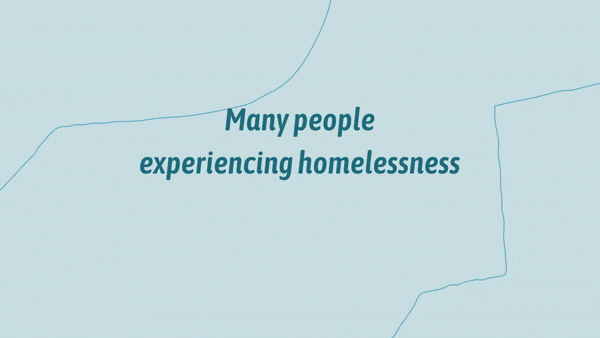
What’s at stake
Mental illness, substance abuse, and homelessness are all crises that must be solved. If we are to solve them, we must understand clearly how they intersect, how they are distinct, and the specific solutions that each demands. The stereotype that people experiencing homelessness have lost housing due to mental illness or substance abuse has misinformed many policies and system-level solutions needed to adequately address mental illness, substance abuse, and homelessness. As many people experiencing homelessness have neither a mental illness nor substance use disorder, policy responses that emphasize treatment for these conditions are not effective in serving this large segment of the population experiencing homelessness. Moreover, for those who do have a mental illness and/or substance use disorder, a prerequisite for effective treatment and care is stable, affordable housing.25
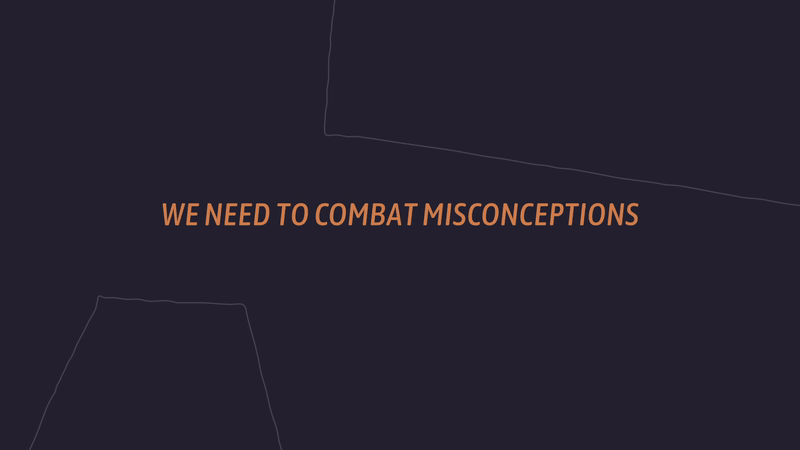
Truth: Homelessness is not a choice. Many people experiencing homelessness are employed or actively seeking employment and would move inside if housing responsive to their needs were available.
Research consistently finds that people believe most individuals experiencing homelessness are “lazy” and could improve their situations if they would simply get a job.26 False perceptions that homelessness allows for endless free time and relieves people from the daily responsibilities of work and family reveal a lack of understanding regarding what homelessness is like and how it occurs.
Related to the misperception is the myth that homelessness is a choice and people experiencing homelessness are “service resistant.” Counter to this false narrative, interviews and surveys find that the large majority of people experiencing homelessness would move inside if safe and affordable housing were available.27 Rather than actively choosing homelessness and resisting high-quality services, the large majority of people experiencing unsheltered homelessness lack an alternative option that feels safe and stable. Temporary shelters are often unsafe and overcrowded,28 and people often exit or avoid shelters out of concerns about personal safety and agency.29
Furthermore, programs that follow a “Treatment-First” approach to housing demand compliance with strict rules and requirements that can be controlling and burdensome, such as mental health treatment, sobriety, and medication adherence.30 The linear path these programs are designed to follow — from shelters to transitional facilities and eventual placement in permanent housing, once a client has complied with treatment and is considered “housing ready” — often entails bureaucratic barriers and lengthy and indeterminate time frames at each stage that can breed frustration and disappointment among people without housing, whose diverse needs are often unmet by such service models. The success of the Housing First model in stably housing individuals over time suggests that when flexible services are offered that are responsive to individuals’ unique needs, people experiencing homelessness are highly receptive.31 As an example, findings from the Denver Supportive Housing Social Impact Bond Initiative, a supportive housing program that uses a Housing First approach to providing permanent housing and wraparound services to people who have experienced homelessness and involvement in the criminal legal system, showed that 90% of the people referred to the program who were located agreed to housing within six months.32
A sizable percentage of the population experiencing homelessness work in the formal labor market. Findings from a national study conducted by researchers at the University of Chicago indicate that 53% of people experiencing sheltered homelessness and over 40% of those experiencing unsheltered homelessness were employed in the year they were observed to be homeless.33 In addition, research across communities demonstrates that many people experiencing homelessness have a job:
- Washington, D.C.: Approximately 22% of single adults experiencing homelessness in 2017 were employed, and 32% of adults in families with children experiencing homelessness were employed.34
- Seattle: Twenty-one percent of those experiencing homelessness in 2020 were employed part-time or full-time.35
- New York City: Employment rates among individuals living in shelters from 1980-2007 were 45% for single adults and 38% for adults in families.36
Many people experiencing homelessness are also actively seeking employment, but they encounter tremendous challenges, including employer stigma, gaps in employment history, lack of a mailing address and/or personal identification, and logistical challenges (e.g., transportation costs, lack of access to facilities to prepare for interviews).
Even people experiencing homelessness who are employed do not have an income that allows them to maintain stable housing. An analysis of national trends using administrative data on income and government program receipt found that average annual earnings from asset income, wage and salary earnings from employment, and social security income for people experiencing sheltered homelessness in 2015 amounted to $8,169 pre-tax. For unsheltered individuals, the mean annual earning was $6,934.37 Even the highest-earning people experiencing homelessness that year did not make enough to cover the cost of a one or two bedroom apartment.
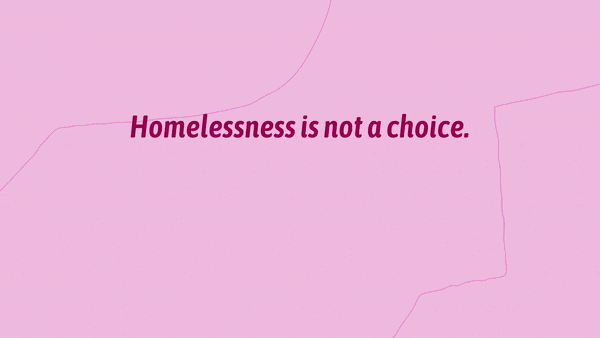
What’s at stake
We will only solve homelessness if we focus on the structural and systemic problems that contribute to homelessness and shore up the public support for social services and policies that can tackle the root causes of homelessness. Viewing homelessness as a choice made out of laziness fuels stigma and holds individuals personally responsible for their homelessness in a manner that contributes to the false narrative that homelessness is unsolvable and justifies the status quo. When people believe that extreme economic disparities are fair and based on merit, it legitimizes existing systems and reduces emotional distress in response to people experiencing homelessness.38 By placing blame on individuals’ personal shortcomings, the stereotype associating homelessness with laziness also diverts focus away from the solutions that have proven to reduce and end homelessness.

Truth: People experiencing homelessness are disproportionately likely to be victims of violent crime.
People experiencing homelessness face disproportionate rates of violent victimization compared to the general population. Compared to 2% of the national population reporting experiences of violent criminal victimization, as many as 49% of individuals experiencing homelessness are estimated to be victims of violence.39 Other research findings of violent victimization among people experiencing homelessness demonstrate devastatingly high levels of risk:
- A study of 350 older adults (50 years or older) experiencing homelessness in Oakland, California, found nearly 12% had experienced physical or sexual assault in the past six months, a violent victimization rate over 10 times higher than that for older adults in the general population. Compared to those who faced persistent homelessness 18 months later, the risk of victimization decreased by half for older adults who regained housing.40
- A study of 300 women experiencing homelessness and unstable housing in San Francisco found that 48% had experienced physical violence in the past six months.41
As experts and advocates report that acts of violence against people experiencing homelessness have been on the rise in recent years,42 the dangers of living without a home may likely be growing greater while the threat to public safety posed by individuals experiencing homelessness remains minimal.
Overlooking these realities, studies demonstrate that the public falsely perceives individuals experiencing homelessness as likely to engage in violent, criminal behavior.43 Further evidence demonstrates that this is a false belief.
- A study of arrest records in Baltimore found that people experiencing homelessness were less likely to commit violent crime than people who were housed.44
- A national survey of incarcerated individuals found that people experiencing homelessness prior to incarceration were more likely to be arrested for a property crime and less likely to be incarcerated for a violent offense.45
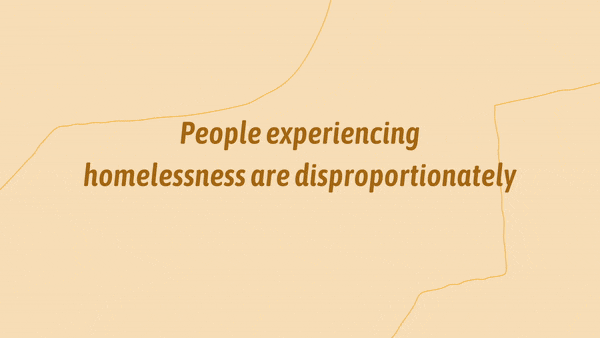
What’s at stake
Negative stereotypes that people experiencing homelessness are dangerous and socially deviant can motivate fear, intolerance, discrimination, and even violence. Rising incidents of hate crimes against people experiencing homelessness are increasingly trivialized and joked about online,46 highlighting the widespread dehumanization of people experiencing homelessness. This stigma about those experiencing homelessness can further fuel punitive and exclusionary anti-homeless legislation, which has increased across states and municipalities in the U.S. since 2006.47
Help spread the truth about homelessness
We’ve created brief videos and sharable content to make it easy to help spread the truth about homelessness — and combat the dangerous myths out there.
Footnotes
- Tsai, Jack, Crystal Yun See Lee, Thomas Byrne, Robert H. Pietrzak, and Steven M. Southwick (2017). Changes in public attitudes and perceptions about homelessness between 1990 and 2016. American Journal of Community Psychology, 60(3-4): 599-606.
- Lindquist, Christine H., Mark Lagory, and Ferris J. Ritchey (1999). The myth of the migrant homeless: An exploration of the psychosocial consequences of migration. Sociological Perspectives, 42(4): 691-709.
- Ganong, Peter, and Daniel Shoag (2017). Why has regional income convergence in the US declined? Journal of Urban Economics, 102: 76-90.
- All Home & Applied Survey Research (2018). Count Us In: Seattle/King County Point-In-Time Count of Persons Experiencing Homelessness.
- Los Angeles Homeless Services Authority (June 2020). Greater Los Angeles Homeless Count: 2019 Results.
- Routhier, Giselle (July 2016). Family Shelter Entrants Come Predominantly From a Few Clustered Neighborhoods.
- San Francisco Department of Homelessness and Supportive Housing & Applied Survey Research (2019). San Francisco Homeless Count & Survey Comprehensive Report 2019.
- Metraux, Steven (October 2015). Migration by veterans who receive VA homeless services. VA National Center on Homelessness Among Veterans and U.S. Department of Veterans Affairs.
- Brand, David (2017). “I didn’t know finding an apartment would be impossible” – Data and Experience Refute the Homeless ‘Magnet Theory’ in New York City and Nationwide. Huffington Post.
- Herz, Rick (1996). No Room for the Inn: A Report on Local Opposition to Housing and Social Services Facilities for Homeless People in 36 United States Cities. National Law Center on Homelessness & Poverty.
- Lyon‐Callo, Vincent (2001). Making sense of NIMBY poverty, power and community opposition to homeless shelters. City & Society, 13(2): 183-209.
Kim, Nathan J., Jessica Lin, Craig Hiller, Chantal Hildebrand, and Colette Auerswald (2021). Analyzing US tweets for stigma against people experiencing homelessness. Stigma and Health. - Dickerson, Mike (December 2020). What America Believes About Homelessness. Invisible People.
- Arumi, Ana Maria, Jonathan Rochkind, Amber Ott, and Andrew L. Yarrow (2007). Compassion, concern, and conflicted feelings: New Yorkers on homelessness and housing. Public Agenda.
- Richards, Jessica, and Randall Kuhn (2022). Unsheltered homelessness and health: A literature review. AJPM Focus: 100043.
- Dickerson, Mike (December 2020). What America Believes About Homelessness. Invisible People.
- Note: Estimates from 138 communities who conducted full unsheltered counts in 2020 and 2021 indicate that approximately 18% of those experiencing homelessness were unsheltered. In the 2017 Point-in-Time count, approximately 35% of those experiencing homelessness were unsheltered, and nearly two-thirds (65%) were staying in emergency shelters or transitional housing.
- U.S. Department of Housing and Urban Development (2022). HUD 2022 Continuum of Care Homeless Assistance Programs Homeless Populations and Subpopulations.
- Los Angeles Homeless Services Authority ( 2018). Greater Los Angeles Homeless Count 2018 Presentation.
- Goodman, Lisa A, Leonard Saxe, and Mary Harvey (1991). Homelessness as psychological trauma. American Psychologist, 46(11): 1219–1225.
Corcoran, C., Walker, E., Huot, R., Mittal, V., Tessner, K., Kestler, L., & Malaspina, D. (2003). The stress cascade and schizophrenia: Etiology and onset. Schizophrenia Bulletin, 29(4): 671–692.
Castellow, Jennifer, Bret Kloos, and Greg Townley (2015). Previous homelessness as a risk factor for recovery from serious mental illnesses. Community Mental Health Journal, 51: 674-684. - Shinn, Marybeth, Jim Baumohl, and Kim Hopper (2001). The prevention of homelessness revisited. Analyses of Social Issues and Public Policy, 1.1: 95-127.
Shinn, Marybeth (2009). Ending Homelessness for Families: The Evidence for Affordable Housing. Washington, DC: National Alliance to End Homelessness and Enterprise Community Partners.
Colburn, G., & Aldern, C. P. Homelessness is a housing problem: How structural factors explain US patterns. Univ of California Press, 2022.
National Coalition for the Homeless (June 2007). Why Are People Homeless? National Coalition for the Homeless. - Colburn, Gregg, and Clayton Page Aldern (2022). Homelessness is a housing problem: How structural factors explain US patterns. Univ of California Press.
- All Home & Applied Survey Research (2019). Count Us In: Seattle/King County Point-In-Time Count of Persons Experiencing Homelessness.
- Snow, David A. and Rachel E. Goldberg (June 2017). Homelessness In Orange County: The Costs to Our Community.
- Applied Survey Research (2022). 2022 Alameda County Homeless Count And Survey Comprehensive Report.
- National Low Income Housing Coalition & National Alliance to End Homelessness (January 2020). The Case for Housing First.
- Link, Bruce G., Sharon Schwartz, Robert Moore, Jo Phelan, Elmer Struening, Ann Stueve, and Mary Ellen Colten (1995). Public knowledge, attitudes, and beliefs about homeless people: Evidence for compassion fatigue? American Journal of Community Psychology, 23,(4): 533-555.
Kim, Nathan J., Jessica Lin, Craig Hiller, Chantal Hildebrand, and Colette Auerswald (2021). Analyzing US tweets for stigma against people experiencing homelessness. Stigma and Health.Hocking, John E., and Samuel G. Lawrence (2000). Changing attitudes toward the homeless: The effects of prosocial communication with the homeless. Journal of Social Distress and the Homeless, 9: 91-110. - The City of Seattle and Applied Survey Research (2016). City of Seattle 2016 Homeless Needs Assessment.
Valencia, Milton ( 2021). ‘A sense of community’: Can the cabins at the Shattuck be an answer to the crisis at Mass. and Cass? The Boston Globe.
Wusinich, Christina, Lynden Bond, Anna Nathanson, and Deborah K. Padgett (2019). “If you’re gonna help me, help me”: Barriers to housing among unsheltered homeless adults.” Evaluation and Program Planning, 76: 101673. - Garrow, Eve & Julia Devanthéry (2019). “This Place is Slowly Killing Me”: Abuse and Neglect in Orange County Emergency Shelters. ACLU Southern California.
- Wusinich, Christina, Lynden Bond, Anna Nathanson, and Deborah K. Padgett (2019). “If you’re gonna help me, help me”: Barriers to housing among unsheltered homeless adults.” Evaluation and Program Planning, 76: 101673.
Davis, Lindsey (2021). View from the Street: Unsheltered New Yorkers and the Need for Safety, Dignity, and Agency. Coalition for the Homeless. - Tsemberis, Sam, Leyla Gulcur, and Maria Nakae (2004). Housing first, consumer choice, and harm reduction for homeless individuals with a dual diagnosis. American Journal of Public Health, 94(4): 651-656.
- National Low Income Housing Coalition & National Alliance to End Homelessness (January 2020). The Case for Housing First.
- Gourevitch, Ruth & Mary K. Cunningham (2019). Dismantling the Harmful, False Narrative That Homelessness Is a Choice. The Urban Institute.
- Meyer, Bruce D., Angela Wyse, Alexa Grunwaldt, Carla Medalia, and Derek Wu (2021). Learning about homelessness using linked survey and administrative data. Working Paper No. w28861. National Bureau of Economic Research.
- The Metropolitan Washington Council of Governments (2017). Homelessness In Metropolitan Washington: Results and Analysis from the Annual Point-in-Time Count of Persons Experiencing Homelessness.
- All Home & Vega Nguyen Research (2020). Count Us In: Seattle/King County Point-In-Time Count of Persons Experiencing Homelessness.
- Metraux, Stephen, Jamison D. Fargo, Nicholas Eng, and Dennis P. Culhane (2018). Employment and earnings trajectories during two decades among adults in New York City homeless shelters. Cityscape, 20(2): 173-202.
- Meyer, Bruce D., Angela Wyse, Alexa Grunwaldt, Carla Medalia, and Derek Wu (2021). Learning about homelessness using linked survey and administrative data. Working Paper No. w28861. National Bureau of Economic Research.
Note: Total income includes wages/salaries, total interest income (taxable and tax-exempt), taxable dividends, alimony, business income, total pensions/annuities, net rents/royalties, farm income, unemployment compensation, and total social security benefits. - Goudarzi, Shahrzad, Ruthie Pliskin, John T. Jost, and Eric D. Knowles. Economic system justification predicts muted emotional responses to inequality. Nature Communications, 11(1): 383.
Williams, Jean Calterone (2016). A roof over my head: Homeless women and the shelter industry. University Press of Colorado. - Meinbresse, Molly, Lauren Brinkley-Rubinstein, Amy Grassette, Joseph Benson, Carol Hall, Reginald Hamilton, Marianne Malott, and Darlene Jenkins (2014). Exploring the experiences of violence among individuals who are homeless using a consumer-led approach. Violence and Victims, 29(1): 122-136.
Truman, Jennifer L., and Michael Rand (2011). National crime victimization survey, criminal victimization. Washington DC: Bureau of Justice Statistics. - Tong, Michelle S., Lauren M. Kaplan, David Guzman, Claudia Ponath, and Margot B. Kushel (2021). Persistent homelessness and violent victimization among older adults in the HOPE HOME study. Journal of Interpersonal Violence, 36, (17-18): 8519-8537.
- Riley, Elise D., Eric Vittinghoff, Rose MC Kagawa, Maria C. Raven, Kellene V. Eagen, Alison Cohee, Samantha E. Dilworth, and Martha Shumway (2020). Violence and emergency department use among community-recruited women who experience homelessness and housing instability. Journal of Urban Health, 97: 78-87.
- Swenson, Kyle (January 2022). Serial murders, beatings and beheadings: Violence against the homeless is increasing, advocates say. The Washington Post.
- Link, Bruce G., Sharon Schwartz, Robert Moore, Jo Phelan, Elmer Struening, Ann Stueve, and Mary Ellen Colten (1995). Public knowledge, attitudes, and beliefs about homeless people: Evidence for compassion fatigue? American Journal of Community Psychology, 23,(4): 533-555.
Tompsett, Carolyn J., Paul A. Toro, Melissa Guzicki, Manuel Manrique, and Jigna Zatakia (2006). Homelessness in the United States: Assessing changes in prevalence and public opinion, 1993–2001. American Journal of Community Psychology, 37(1-2): 29-46. - Fischer, Pamela J (1988). Criminal activity among the homeless: A study of arrests in Baltimore. Psychiatric Services, 39,(1): 46-51.
- Greenberg, Greg A., and Robert A. Rosenheck (2008). Jail incarceration, homelessness, and mental health: A national study. Psychiatric Services, 59,(2): 170-177.
- Kim, Nathan J., Jessica Lin, Craig Hiller, Chantal Hildebrand, and Colette Auerswald (2021). Analyzing US tweets for stigma against people experiencing homelessness. Stigma and Health.
- The National Homelessness Law Center (2021). Housing Not Handcuffs 2021: State Law Supplement.
The National Law Center on Homelessness & Poverty (2019). Housing Not Handcuffs 2019: Ending the Criminalization of Homelessness in U.S. Cities.




